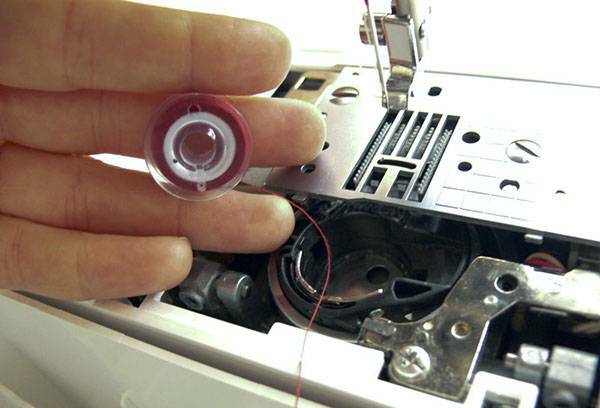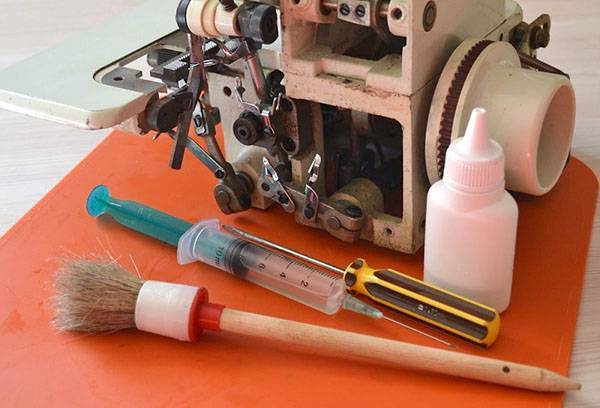
Cleaning of internal components of
One of the most common causes of breakages is the clogging of the internal mechanism, entailing jamming. And after all, expensive repairs can be avoided by remembering the removal of dust in time. But it is not enough to wipe the casing and adjustments of the sewing machine with a cloth: you will have to remove the internal elements from the villi, scraps of filaments and small pieces of fabric. This is done simply, and ideally such cleaning can be carried out at least once after the completion of work. But even for those who are lazy, everything is not lost: if the machine is not used too often, then you can take care of it 1-2 times in six months. What is the care at this stage?
Important!
If you often work with knitwear, fur or wool, you need to clean the machine more often, as these materials leave behind a large number of villi, capable of quickly hammering the mechanism.
- The machine must first be turned off from the network, and also for safety and convenience of work it is better to remove the needle.
- The needle plate must be unscrewed, the shuttle can be disassembled according to the instructions to your typewriter. It sounds difficult, but in fact after the first cleansing you will understand that no special skills are required here.
- Clearing of dust in the first place will have a niche under the needle plate, the shuttle and the bobbin case, since the dirt basically accumulates there.
- Dust is cleaned with hard and soft brushes, while for small and complex parts like a shuttle, a soft brush is preferable.
- Wrapped threads and large pieces of fabric can be removed with tweezers, and the accumulation of dust in the corners is conveniently pinned with a needle. Only it is better to use its blunt end to avoid scratches on the mechanism.
- Another rule of care when cleaning: do not use a damp rag on the habit. Oil and dust can only be removed from the parts with a dry napkin, otherwise rust, which is already formed in small quantities, can not be avoided.
Ignoring the cleaning can lead to failure of the mechanism of tissue advancement, and also increase the load on the drive of the machine, which can lead to more serious damage.

Tip
Dust can also get inside the sewing machine controllers, so cleaning them from dirt is equally important, although this is just a small part of the care of sewing machines.
To clean as rarely as possible, the machine is advised to store in a special case: so the dust will have almost no access to internal mechanisms. Well, in order to further protect the niche under the needle plate, before putting the machine into the cover, a thick fabric is put under the foot to close the needle holes.

Lubrication of parts
If sewing is your hobby and the machine does not work for days on a span, then lubricate it only once every six months or even a year. With modern machines, you need to do this in a preventive manner in order to increase the service life, although, of course, on a greased machine it will be much more pleasant to work.
- Let's start with the fact that you can lubricate the machine only after cleaning, which consists not only in cleaning the dust, but also in removing rust and old oil from the internal mechanism. They can be removed with a dry cloth, lifting the plastic cover.
- How to properly carry out the lubrication process of your model, better than in the instructions, is not said anywhere. Study it before you take on the lubrication oil can: it is possible for your machine to handle the parts only manually, or it may be enough to drop a couple of drops of oil in a special lubrication hole.
- Lube oil is suitable only for special, machine. Other oils for care of the sewing machine are not suitable, and it is better to buy the product in a specialized store.
- After lubricating the internal elements, scroll 2-3 times the flywheel on yourself, so that the distribution of the parts is not much better. Do not use the machine immediately, otherwise you will dirty the fabric. We advise you to make a kind of oil drain by placing a cloth under the presser foot and lowering the needle into it. After a while, excess oil drains into the fabric, and the machine will be ready for use.
- Periodically in the lubrication need and regulators of the sewing machine: their metal base eventually also begins to rotate worse and becomes rusted.
As you can see, caring for a sewing machine is not anything complicated, and if you still remember the regular needle change, you will properly thread the thread and not use the machine for work that exceeds its capabilities, then your assistant will serve you very muchand very long.



